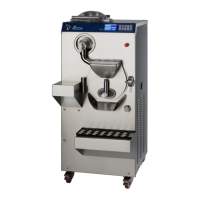15
Prior to connecting the appliance to the power source, the temperature,
pressure and water flow from the water supply network must be checked.
Permitted water temperature and water pressure from the water supply network:
Water supply must be checked for all conditions that are required for alimentary
use.
Low water pressure causes the cooling system to function improperly. The
cooling gas does not condense, thus causing the compressor to overload. In
such cases, the safety pressure valve kicks in and switches off the compressor.
The results of mixture treating and ice cream production when the water
pressure is too low are not as good as when the water pressure is normal.
The maximum presence of chlorides in water is 120 ppm. Exchangers are not
suitable for the use of salt water.
4.3 ELECTRICITY SUPPLY REQUIREMENTS
Prior to connecting the appliance to the power source, the voltage and the
maximum power current allowed in the network must be checked and the
appliance must be protected externally with FUSES and the MAIN SWITCH.
Permitted voltage of three-phase appliances (400/50/3):
Permitted voltage of three-phase appliances (230/50/3):
Permitted voltage of one-phase appliances (230/50/1):
Permitted voltage of one-phase appliances (208-220/60/3):
Permitted voltage of one-phase appliances (208-220/60/1):
The diameter of each phase conductor must be of an appropriate dimension
(corresponding to the power of the fuses).
WATER TEMPERATURE
5°C 30°C
WATER PRESSURE 100kPa (1bar) 800kPa (8bar)
WATER FLOW 400 l/h /
400V 380V (400V–5%) 420V (400V+5%)
230V 220V (230V–5%) 240V (230V+5%)
230V 220V (230V–5%) 240V (230V+5%)
208-220V 208V 220V
208-220V 208V 220V

